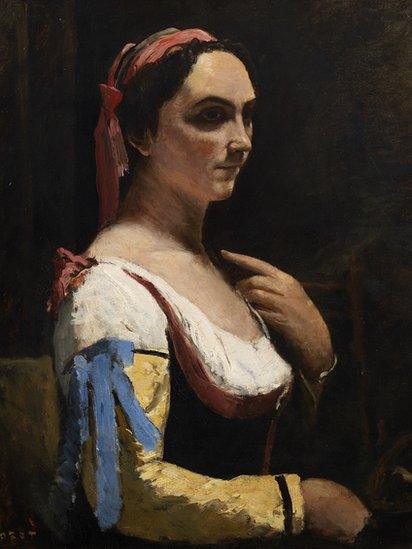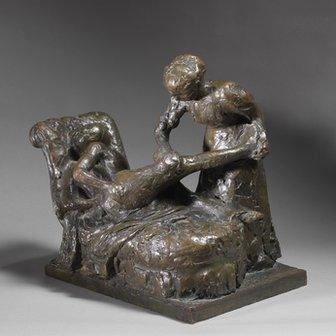Lucian Freud donates Corot and Degas works in lieu of tax
- Published

The painting is an example of Corot’s later works where he often painted peasant figures
The estate of British painter Lucian Freud has bequeathed works by Corot and Degas to the nation, under the government's acceptance in lieu scheme.
The artist, who died in 2011, specified in his will that the artworks should be donated in place of inheritance tax.
Freud bought the Corot portrait at an auction in 2001 and it had hung on the top floor of his London home.
The Corot will go to the National Gallery, external while three Degas sculptures will be shown at The Courtauld Gallery, external.
Jean-Baptiste Camille Corot was a leading mid-19th Century French painter who was a particular influence on the Impressionists.
His portraits were never exhibited by the artist during his lifetime.
The painting, L' Italienne ou La Femme á la Manche Jaune (The Italian Woman, or Woman with Yellow Sleeve) has not been seen in public for more than 60 years and dates from the last years of Corot's life.
Prior to Freud's purchase of the painting in 2001, it was once owned by Hollywood star Edward G Robinson.
The bronze sculptures, Horse Galloping on Right Foot; La Masseuse (The Masseuse); and Portrait of a Woman: Head Resting on One Hand were cast from wax models by Degas - considered one of the greatest artists of the late 19th Century.
Public display

Painter and sculptor Degas was well-known for his work portraying dancers
Alan Davey, Chief Executive, Arts Council England, called the acceptance in lieu (AIL) scheme "a great success story for this country's cultural heritage".
He added the scheme had made "thousands of important pieces of art made available for public display".
Culture Secretary Maria Miller said she was "delighted that these magnificent works by Corot and Degas will now be on permanent public display, where they can be enjoyed by all".
Freud, who was widely considered to be Britain's greatest living artist before his death at the age of 88, fled to the UK from Germany with his family to escape the Nazis. He became a British citizen in 1939.
A retrospective of his work at the National Portrait Gallery last May attracted more than 175,000 visitors in a matter of weeks, making it the gallery's most popular paid-for show.
- Published8 November 2012
- Published7 March 2012
- Published20 August 2010